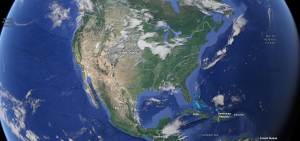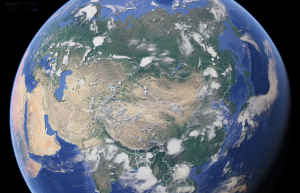by DAVID BROWN | CLEARNFO.com | June 24, 2015
Interesting, but lengthy analysis of Mackinder and Zbig’s theory of the World Island from 2006 in the link below. Though Eurasia may not possess the specific strategic qualities identified by Mackinder, it is nonetheless the major game on today’s geopolitical stage, bringing together Russia and China while the Anglo-American Establishment (represented by US/UK) is being left out in the cold.
As a result of my Anglo-American education, most maps I grew up with had the USA as the center of the known universe with the globe slightly tilted to display more of the northern hemisphere. And of course across ‘the pond’ was Western Europe. However, if we reposition our vantage point to be centered over central Asia, the world takes on an entirely new flavor. This view is a view of the great ‘World Island’ (including China, Russia, Middle East, Africa, India, Europe, the *stans, etc.) and is what our geopolitical planners and of course Russia, China and others are keenly aware of. From the late 16th century to WWI (World War One), the British extended and maintained its empire by controlling the seas. After the Empire’s pentacle of power marked by WWI, the control of the seas was bequeathed to Briton’s Prodigal child, the USA. Implicit in controlling the seas is the desire to control the land masses behind the seas since it is far easier and less expensive to control the seas and project power from the seas than to attempt to control all the land inland. So, from WWII to present, this has been the USA’s default position. Control of the seas was essential to control those who lived on the land behind the seas.
China and Russia fully understand they are no match for the military might of the USA, but the USA is heavily committed to the old, outdated British paradigm of controlling the seas to control the land. Zbig and others recognized this one dimensional weakness and set about new methods and strategies (including Gladio Operations, Color Revolutions, NGOs, forward NATO bases, USAID, World Bank, IMF, etc) to contain their existing vassal states and to bring Russia and China under control or at a minimum limit their ability to contest the primacy of the mono-polar world of the Anglo-American power structure. If you look at a map of US Military and NATO bases, you will quickly discover the USA’s plan of encircling and containing Russia and China.
Russia and China are pragmatic and realize that they cannot control the seas or directly contest the USA’s massive military; so have decided to go inland, rehydrate the old Silk Road and build a new financial infrastructure without the Anglo-American Establishment’s permission.
“A victorious Roman general, when he entered the city, amid all the head-turning splendor of a `Triumph,’ had behind him on the chariot a slave who whispered into his ear that he was mortal. When our statesmen are in conversation with the defeated enemy, some airy cherub should whisper to them from time to time this saying: Who rules East Europe commands the Heartland; Who rules the Heartland commands the World-Island; Who rules the World-Island commands the World.” –Sir Halford Mackinder, 1919
“Paradoxically, our attempts to prevent a Eurasian anti-American alliance may make that outcome more likely. As Steven Walt has persuasively shown, imbalances of threat, not imbalances of power, drive alliances together. Our attempts to project power into the Heartland, if done clumsily, can heighten threat perceptions in its capitals, making such counterproductive alliances more attractive.” – Christopher J. Fettweis
Eurasia, the “World Island”: Geopolitics, and Policymaking in the 21st Century
By Christopher J. Fettweis Global Research, March 14, 2006
Additional Reading:
- The Geographical Pivot of History (Wikipedia)
- The Geopolitical Chessboard (ClearNFO)
- George Friedman, “Europe: Destined for Conflict?”(ClearNFO)
- Mackinder Reincarnates–Now Hungary Joins Silk Road 09.07.2015 Author: F. William Engdahl
- The Great Game (Wikipedia)
- The New Great Game by Christoph Germann
- China: End Run for World Domination


